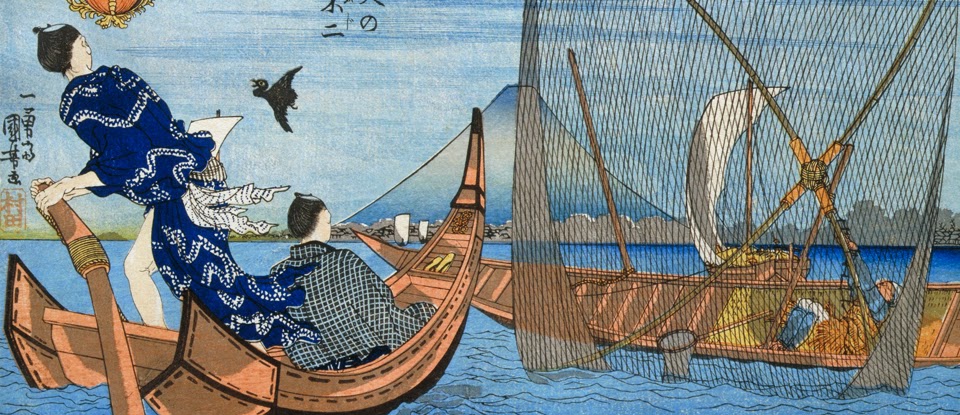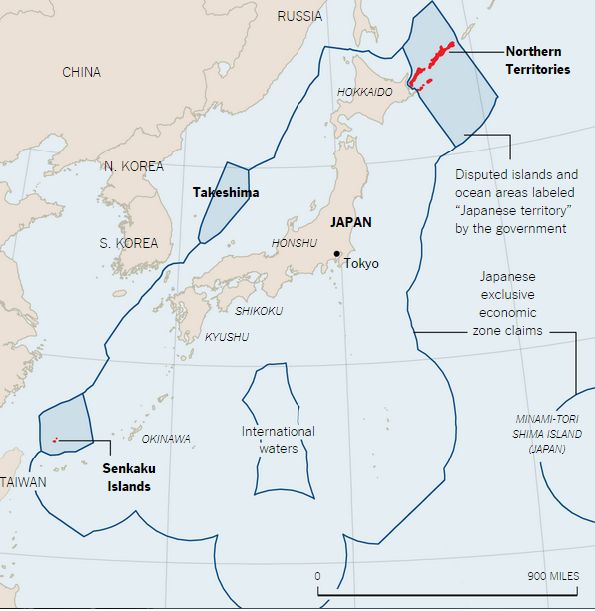Social Sciences
First published in The New York Times
January 16, 2015
TOKYO- Bolstered by his party's victory in Diet elections last month, Prime Minister Shinzo Abe has renewed his vow to free Japan from the fetters of the past, especially its defeat in World War II. Mr. Abe and his supporters view the prevailing accounts of that era as "masochistic" and a hindrance to taking pride in what he calls the "new Japan." They propose to modify the article in Japan's Constitution that sates the Japanese people "forever renounce war as a sovereign right of the nation."
These aspirations have been laid out in a map of Japan that the Japanese Foreign Ministry published on its website last April, with translations in 12 languages. The map extends beyond Japan's internationally recognized boundaries, incorporating in the name of ryodo - or the "inherent territory" of Japan - many islands claimed by neighboring countries. Those lands, the argument goes, are integral to Japan's very being.
In fact, the Abe government's expansionist view undermines Japan's interests, both economic and strategic.
Ryodo promotes a notion of Japan's territory that circumvents history, particularly the history of how Japan laid claim to these islands in the first place - through imperial wars with China and Russia, through wars of conquest against Koreans, through the extermination or assimilation of indigenous peoples.
Partly as a result, Japan is embroiled in many territorial disputes. China and Taiwan contest the Senkaku Islands, which Beijing calls the Diaoyu and Taipei and Diaoyutai. South Korea claims Takeshima (calling it Dokdo) where it has stationed military police since 1954. Russia claims sovereignty over what Japanese know as the Northern Territories, four islands in the Kuril chain northeast of Hokkaido where Russians have lived since 1945, numbering about 20,000 today.
Under the terms of the United Nations Convention on the Law of the Sea (UNCLOS), Japan already has access to vast fisheries and rides up to $3.6 trillion in seabed materials. The disputed islands would add much more.
'Inherent' Japan
Tokyo is more aggressively claiming island groups that have long been in territorial dispute. The government highlighted these 3 areas on a new map.
According to some estimates, including by the U.S. Energy Information Administration, the East China Sea holds 200 million barrels in proved and probable oil reserves (the world consumes around 90 million barrels of liquid fuels each day) and between 1 and 2 trillion cubic feet of natural gas (the United States consumed about 26 trillion cubic feet in 2013). Japan and China contest nearly 17 percent of the sea.
- Japan Urged To Take Pride In Admitting To Troubled Past
On January 12th, Kyodo News interviewed APP member Columbia University Professor Gerald Curtis. He described Japan's ties with China and South Korea as "worrisome," with the "history issue" as an underlying factor. His advice was for Japan to...
- Abe's Shrine Visit Raises Risk Of Conflict: Analysts
AFP reporting by Harumi Ozawa on December 27, 2013. Tokyo ? Prime Minister Shinzo Abe's inflammatory visit to a Tokyo war shrine demonstrates his determination to drag pacifist Japan to the right, and nudges northeast Asia a significant step...
- China?s Evolving ?core Interests?
An editorial in The New York Times on May 11, 2013 (in print on May 12, 2013, on page SR10) chastises the Chinese for defining the Senkaku/Diaoyu Islands as "core interests" that will be defended and the Japanese for casting doubt on their willingness...
- Times Echoes American Frustration With Japan
Masakaki OfferingThe New York Times April 23, 2013 Japan?s Unnecessary Nationalism By THE EDITORIAL BOARD Since taking over as Japan?s prime minister in December, Shinzo Abe and his conservative Liberal Democratic Party have been juggling a packed agenda...
- Japan's Cautious Hawks
In Japan's Cautious Hawks: Why Tokyo Is Unlikely to Pursue an Aggressive Foreign Policy published in the March/April 2013 issue of Foreign Affairs, APP member and Columbia University Professor Gerald L. Curtis argues...
Social Sciences
The Shape of Japan to Come

by Alexis Dudden, a professor of history at the University of Connecticut and APP member
First published in The New York Times
January 16, 2015
TOKYO- Bolstered by his party's victory in Diet elections last month, Prime Minister Shinzo Abe has renewed his vow to free Japan from the fetters of the past, especially its defeat in World War II. Mr. Abe and his supporters view the prevailing accounts of that era as "masochistic" and a hindrance to taking pride in what he calls the "new Japan." They propose to modify the article in Japan's Constitution that sates the Japanese people "forever renounce war as a sovereign right of the nation."
These aspirations have been laid out in a map of Japan that the Japanese Foreign Ministry published on its website last April, with translations in 12 languages. The map extends beyond Japan's internationally recognized boundaries, incorporating in the name of ryodo - or the "inherent territory" of Japan - many islands claimed by neighboring countries. Those lands, the argument goes, are integral to Japan's very being.
In fact, the Abe government's expansionist view undermines Japan's interests, both economic and strategic.
Ryodo promotes a notion of Japan's territory that circumvents history, particularly the history of how Japan laid claim to these islands in the first place - through imperial wars with China and Russia, through wars of conquest against Koreans, through the extermination or assimilation of indigenous peoples.
Partly as a result, Japan is embroiled in many territorial disputes. China and Taiwan contest the Senkaku Islands, which Beijing calls the Diaoyu and Taipei and Diaoyutai. South Korea claims Takeshima (calling it Dokdo) where it has stationed military police since 1954. Russia claims sovereignty over what Japanese know as the Northern Territories, four islands in the Kuril chain northeast of Hokkaido where Russians have lived since 1945, numbering about 20,000 today.
Under the terms of the United Nations Convention on the Law of the Sea (UNCLOS), Japan already has access to vast fisheries and rides up to $3.6 trillion in seabed materials. The disputed islands would add much more.
'Inherent' Japan
Tokyo is more aggressively claiming island groups that have long been in territorial dispute. The government highlighted these 3 areas on a new map.
 |
| Sources: ministry of Foreign Affairs of Japan: maritimeregions.org |
A volcano on one of the southern Kurils has rhenium, a rare-earth metal with a melting point that makes jet-engine designers dream. There are also vast quantities of untapped methane hydrate in the seabed between Japan and the Korean Peninsula. After gas was extracted from similar deposits elsewhere for the first time in 2013, a spokesman for the Japan Oil, Gas and Metals National Corporation said, "Japan could finally have an energy source to call its own."
The lure of such riches might seem like reason enough for resource-poor Japan to claim these territories. The government spent $250 billion on imported fuel in 2012. And the cost of decommissioning the nuclear reactors at Fukushima after the meltdown following the March 2011 tsunami is expected to reach at least $90 billion.
Yet Japan risks losing access to many of these resources because of its brinksmanship. UNCLOS does not determine sovereignty over land, and it allows for joint development agreements in waters around contested territory. When disputes heat up, however, they naturally tend to scuttle any joint schemes.
In 2008 China and Japan agreed to explore together four gas fields in the East China Sea. But the project was scuttled the following year, after China went at it alone. Mr. Abe's maximalist policy only undermines the prospects that his development project could be revived, or that new ones involving Japan might be struck.
The costs of Mr. Abe's territorial revisionism are also strategic. Ryodo implicitly dismisses as partial the terms of the 1951 San Francisco Peace Treaty, which formally ended World War II between Japan and the Allies. The agreement redrew Japan from the massive empire it had become during the war - stretching from northern China to Guadalcanal - more or less into the country familiar today. (Some islands, notably Okinawa, reverted to Japan in the intervening years.) Many Japanese at the time, including Mr. Abe's grandfather, Nobusuke Kishi - who was accused of being a Class A war criminal - were infuriated, claiming in particular that the Kurils were "essential" to the Japanese.
In a separate agreement that went into force at the same time, the U.S.-Japan Security Treaty of 1951, the United States would "maintain armed forces of its own in and about Japan" in order "to deter armed attack upon Japan." By the time the treaty was revised in 1960, Japan had acquired limited self-defense forces, and the two countries undertook various commitments in case of "an armed attack against either Party in the territories under the administration of Japan." These still stand today, hence the critical importance also for the U.S. government of properly defining what Japan is.
Officials in Washington and Tokyo are currently reviewing each side's responsibilities in the event of the threat of the peace and security of Japan. One fraught issue is the United States' dual obligation, under separate security arrangements, to defend both Japan and South Korea because one could attack the other over territory they both claim. In other words, the very notion of ryodo challenges the United States' postwar security commitments even as it risks triggering them.
Mr. Abe's revanchist view of the past is central to his vision of a future in which Japan "once again shines on the world's center stage." But it distorts history in a way that undermines the country's major interests and, arguably, its identity. The constitutional changes advocated by Mr. Abe's party include an "obligation" for citizens of Japan to "defend the nation's inherent territory, inherent seas and inherent skies," disputed islands and all. The proposed draft adds that, "All citizens must honor the Constitution," suggesting that failure to do so could endanger their rights, maybe their citizenship. In his bid to claim more for Japan, Mr. Abe may reap less.
- Japan Urged To Take Pride In Admitting To Troubled Past
On January 12th, Kyodo News interviewed APP member Columbia University Professor Gerald Curtis. He described Japan's ties with China and South Korea as "worrisome," with the "history issue" as an underlying factor. His advice was for Japan to...
- Abe's Shrine Visit Raises Risk Of Conflict: Analysts
AFP reporting by Harumi Ozawa on December 27, 2013. Tokyo ? Prime Minister Shinzo Abe's inflammatory visit to a Tokyo war shrine demonstrates his determination to drag pacifist Japan to the right, and nudges northeast Asia a significant step...
- China?s Evolving ?core Interests?
An editorial in The New York Times on May 11, 2013 (in print on May 12, 2013, on page SR10) chastises the Chinese for defining the Senkaku/Diaoyu Islands as "core interests" that will be defended and the Japanese for casting doubt on their willingness...
- Times Echoes American Frustration With Japan
Masakaki OfferingThe New York Times April 23, 2013 Japan?s Unnecessary Nationalism By THE EDITORIAL BOARD Since taking over as Japan?s prime minister in December, Shinzo Abe and his conservative Liberal Democratic Party have been juggling a packed agenda...
- Japan's Cautious Hawks
In Japan's Cautious Hawks: Why Tokyo Is Unlikely to Pursue an Aggressive Foreign Policy published in the March/April 2013 issue of Foreign Affairs, APP member and Columbia University Professor Gerald L. Curtis argues...
